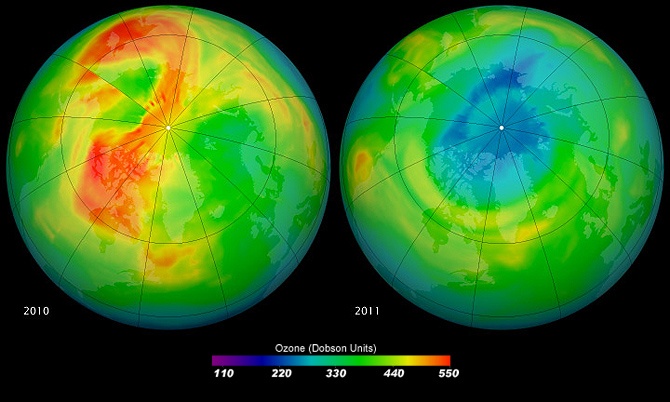NASA Discovers Significant Ozone Hole Over The Arctic

Maps of ozone concentrations over the Arctic come from the Ozone Monitoring Instrument (OMI) on NASA’s Aura satellite. The left image shows March 19, 2010, and the right shows the same date in 2011. March 2010 had relatively high ozone, while March 2011 has low levels. Image: NASA
According to an article by NASA scientists published in the journal Nature the ozone layer over the Arctic reached unprecedentedly low levels during the winter of 2010-2011 and for the first time a significant ozone hole was recorded. Ozone is a molecule consisting of three oxygen atoms and is responsible for absorbing the vast majority of the Sun’s harmful ultraviolet radiation.
The paper states that “chemical ozone destruction over the Arctic in early 2011 was – for the first time in the observational record – comparable to that in the Antarctic ozone hole. Unusually long-lasting cold conditions in the Arctic lower stratosphere led to persistent enhancement in ozone-destroying forms of chlorine and to unprecedented ozone loss, which exceeded 80 percent.”
The scientists cite the dramatic depletion of ozone over the region as an example how sudden anomalies can occur as a result of human activity that ended decades ago, in this case the release of chlorinated fluorocarbons (CFCs).
The emission of CFCs, once prevalent in aerosol sprays, air conditioning units, and refrigerators, led to a dramatic depletion of ozone over the Antarctic in the 1980s. Under the Montreal Protocol, which entered into force in 1989 and has been ratified by 191 countries, such emissions were banned and the ozone layer over the south pole has begun to recover.
According to Michelle L. Santee, a planetary scientist at NASA’s Jet Propulsion Laboratory, “the root cause [of the ozone hole over the Arctic] is the residual products from the CFCs that were released throughout the 20th century.” Due to the longevity of these compounds it will take many decades before the level of CFCs in the stratosphere, the layer of the atmosphere from about 10 to 20 miles (15 to 35 kilometers), starts to decrease noticeably.
While surface temperatures in the Arctic have been warming over the past decades, temperatures in the stratosphere, where ozone and CFCs can be found, have been increasingly cold during in recent years. According to Gloria Manney, a lead author of the article, “the difference from previous winters is that temperatures were low enough to produce ozone-destroying forms of chlorine for a much longer time. This implies that if winter Arctic stratospheric temperatures drop just slightly in the future, for example as a result of climate change, then severe Arctic ozone loss may occur more frequently.” The colder the surrounding air, the faster the CFCs interact with and break down the ozone.
In contrast to the ozone hole over Antarctica which occurs far removed from population centers, the Arctic hole may have exposed people in Eurasia’s northern latitudes to higher-than-normal levels of UV radiation during winter and spring of 2011. While the ozone hole over the south pole has formed every year since the 1980s, NASA’s scientists consider the depletion over the Arctic to be temporary.